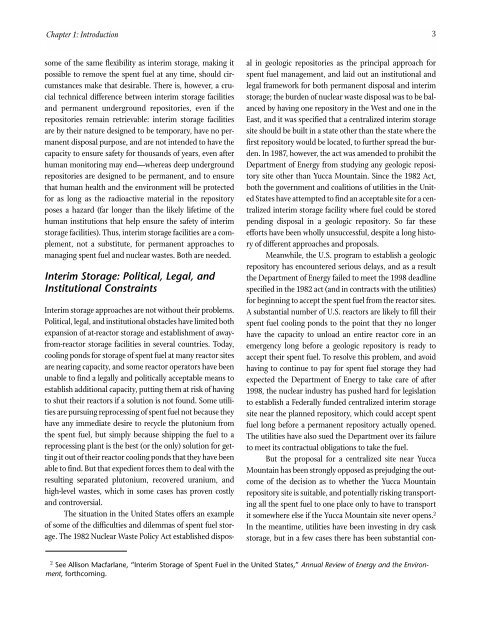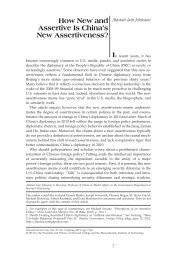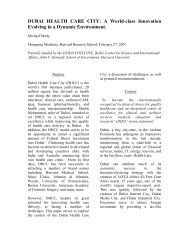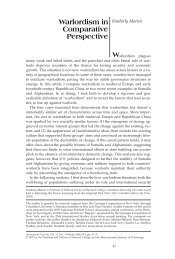Interim Storage of Spent Nuclear Fuel - Woods Hole Research Center
Interim Storage of Spent Nuclear Fuel - Woods Hole Research Center
Interim Storage of Spent Nuclear Fuel - Woods Hole Research Center
You also want an ePaper? Increase the reach of your titles
YUMPU automatically turns print PDFs into web optimized ePapers that Google loves.
Chapter 1: Introduction 3<br />
some <strong>of</strong> the same flexibility as interim storage, making it<br />
possible to remove the spent fuel at any time, should circumstances<br />
make that desirable. There is, however, a crucial<br />
technical difference between interim storage facilities<br />
and permanent underground repositories, even if the<br />
repositories remain retrievable: interim storage facilities<br />
are by their nature designed to be temporary, have no permanent<br />
disposal purpose, and are not intended to have the<br />
capacity to ensure safety for thousands <strong>of</strong> years, even after<br />
human monitoring may end—whereas deep underground<br />
repositories are designed to be permanent, and to ensure<br />
that human health and the environment will be protected<br />
for as long as the radioactive material in the repository<br />
poses a hazard (far longer than the likely lifetime <strong>of</strong> the<br />
human institutions that help ensure the safety <strong>of</strong> interim<br />
storage facilities). Thus, interim storage facilities are a complement,<br />
not a substitute, for permanent approaches to<br />
managing spent fuel and nuclear wastes. Both are needed.<br />
<strong>Interim</strong> <strong>Storage</strong>: Political, Legal, and<br />
Institutional Constraints<br />
<strong>Interim</strong> storage approaches are not without their problems.<br />
Political, legal, and institutional obstacles have limited both<br />
expansion <strong>of</strong> at-reactor storage and establishment <strong>of</strong> awayfrom-reactor<br />
storage facilities in several countries. Today,<br />
cooling ponds for storage <strong>of</strong> spent fuel at many reactor sites<br />
are nearing capacity, and some reactor operators have been<br />
unable to find a legally and politically acceptable means to<br />
establish additional capacity, putting them at risk <strong>of</strong> having<br />
to shut their reactors if a solution is not found. Some utilities<br />
are pursuing reprocessing <strong>of</strong> spent fuel not because they<br />
have any immediate desire to recycle the plutonium from<br />
the spent fuel, but simply because shipping the fuel to a<br />
reprocessing plant is the best (or the only) solution for getting<br />
it out <strong>of</strong> their reactor cooling ponds that they have been<br />
able to find. But that expedient forces them to deal with the<br />
resulting separated plutonium, recovered uranium, and<br />
high-level wastes, which in some cases has proven costly<br />
and controversial.<br />
The situation in the United States <strong>of</strong>fers an example<br />
<strong>of</strong> some <strong>of</strong> the difficulties and dilemmas <strong>of</strong> spent fuel storage.<br />
The 1982 <strong>Nuclear</strong> Waste Policy Act established dispos-<br />
al in geologic repositories as the principal approach for<br />
spent fuel management, and laid out an institutional and<br />
legal framework for both permanent disposal and interim<br />
storage; the burden <strong>of</strong> nuclear waste disposal was to be balanced<br />
by having one repository in the West and one in the<br />
East, and it was specified that a centralized interim storage<br />
site should be built in a state other than the state where the<br />
first repository would be located, to further spread the burden.<br />
In 1987, however, the act was amended to prohibit the<br />
Department <strong>of</strong> Energy from studying any geologic repository<br />
site other than Yucca Mountain. Since the 1982 Act,<br />
both the government and coalitions <strong>of</strong> utilities in the United<br />
States have attempted to find an acceptable site for a centralized<br />
interim storage facility where fuel could be stored<br />
pending disposal in a geologic repository. So far these<br />
efforts have been wholly unsuccessful, despite a long history<br />
<strong>of</strong> different approaches and proposals.<br />
Meanwhile, the U.S. program to establish a geologic<br />
repository has encountered serious delays, and as a result<br />
the Department <strong>of</strong> Energy failed to meet the 1998 deadline<br />
specified in the 1982 act (and in contracts with the utilities)<br />
for beginning to accept the spent fuel from the reactor sites.<br />
A substantial number <strong>of</strong> U.S. reactors are likely to fill their<br />
spent fuel cooling ponds to the point that they no longer<br />
have the capacity to unload an entire reactor core in an<br />
emergency long before a geologic repository is ready to<br />
accept their spent fuel. To resolve this problem, and avoid<br />
having to continue to pay for spent fuel storage they had<br />
expected the Department <strong>of</strong> Energy to take care <strong>of</strong> after<br />
1998, the nuclear industry has pushed hard for legislation<br />
to establish a Federally funded centralized interim storage<br />
site near the planned repository, which could accept spent<br />
fuel long before a permanent repository actually opened.<br />
The utilities have also sued the Department over its failure<br />
to meet its contractual obligations to take the fuel.<br />
But the proposal for a centralized site near Yucca<br />
Mountain has been strongly opposed as prejudging the outcome<br />
<strong>of</strong> the decision as to whether the Yucca Mountain<br />
repository site is suitable, and potentially risking transporting<br />
all the spent fuel to one place only to have to transport<br />
it somewhere else if the Yucca Mountain site never opens. 2<br />
In the meantime, utilities have been investing in dry cask<br />
storage, but in a few cases there has been substantial con-<br />
2 See Allison Macfarlane, “<strong>Interim</strong> <strong>Storage</strong> <strong>of</strong> <strong>Spent</strong> <strong>Fuel</strong> in the United States,” Annual Review <strong>of</strong> Energy and the Environment,<br />
forthcoming.

















